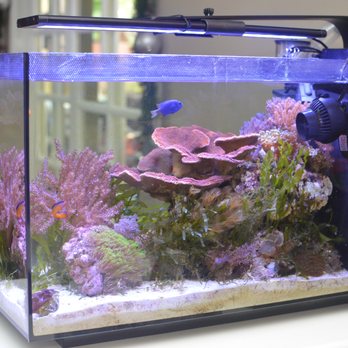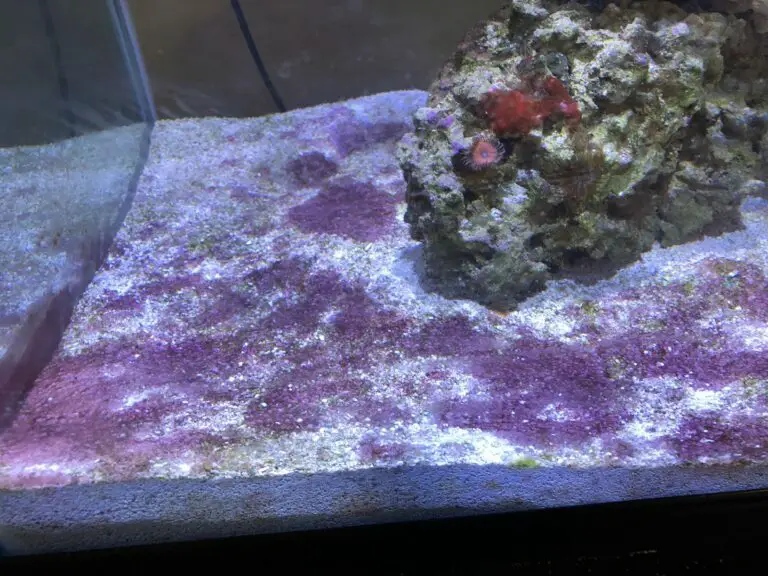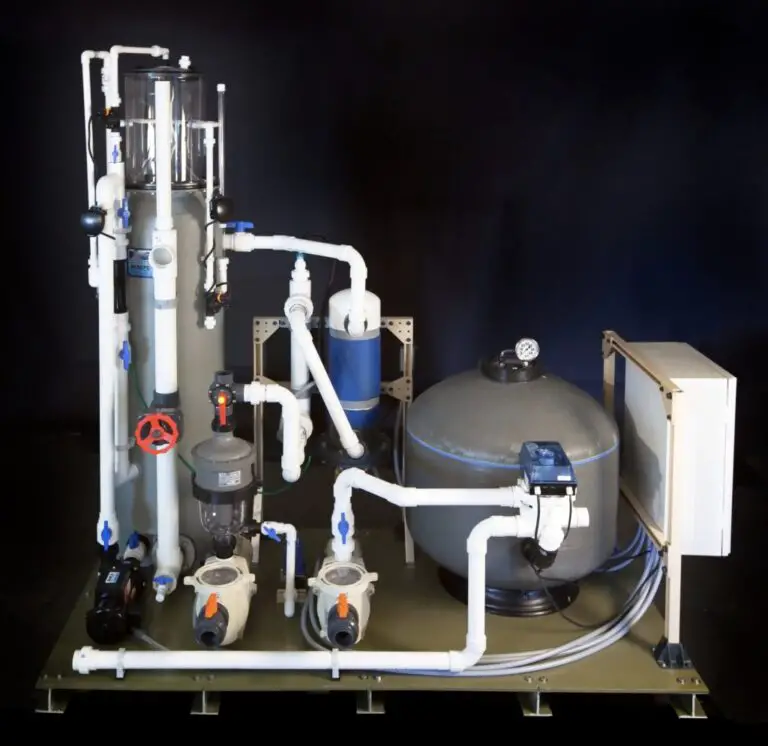What Size Fish Tank Filter Do I Get?
The filter size for your fish tank is contingent on the size of your aquarium. As a rule of thumb, it’s advisable to opt for a filter that can handle four times the water volume of your tank.
Take for instance, if your aquarium holds 20 gallons of water, you should aim for a filter rated at 80 gallons per hour (GPH).
A filter with a higher GPH rating can clean your tank more quickly and efficiently.
It’s crucial to select a robust brand that can provide sufficient mechanical and biological filtration over the years.
Should your aquarium be a diverse ecosystem of various species or home to more assertive fish, it may be prudent to contemplate a stronger filter model.
This would act as a vigilant guard, protecting your aquatic environment from the build-up of waste or other potential contaminants.
When buying a fish tank filter, take into account the size of your aquarium and the species of fish inhabiting it.
A larger aquarium necessitates a more potent filter with greater flow rates for effective filtration.
Some species might require stronger currents or additional filtration based on their needs.
In the end, selecting the right size and type of filter is vital for maintaining a clean and healthy aquatic habitat!
Understanding Fish Tank Filters
Fish tank filters are essential for removing excess food, decaying organic matter, free-floating particulate, dangerous chemicals, and toxins.
They also aid in oxygenation, crucial for the survival of fish.
The three types of filtration
– mechanical, biological, and chemical
– handle different aspects of water cleaning.
The size of the filter you need depends on the volume of your tank, the number of fish, and the type of fish you have.
Fish Tank Filter Size Chart
Here are some general guidelines for filter sizes based on the tank size:
- 60 Litre Tank: A filter with a flow rate of at least 240 litres per hour.
- 100 Litre Tank: A filter with a flow rate of at least 400 litres per hour.
- 150 Litre Tank: A filter with a flow rate of at least 600 litres per hour.
- 200 Litre Tank: A filter with a flow rate of at least 800 litres per hour.
- 300 Litre Tank: A filter with a flow rate of at least 1200 litres per hour.
These are general guidelines, and the specific needs of your fish and plants, as well as the type of tank (e.g., planted, reef), can affect the optimal filter size.
Fish Tank Filter Size Calculator
While the above chart provides a general guideline, it’s important to note a few things.
The specific needs of your fish and plants can affect the optimal filter size.
The type of tank, such as whether it’s planted or a reef, can also influence the filter size you need.
Therefore, it’s always a good idea to use a fish tank filter size calculator.
Fish tank filter size calculators are quite comprehensive in their approach.
They consider the size of your tank. This is a crucial factor as larger tanks require more powerful filters.
They take into account the number of fish you have. More fish produce more waste, necessitating a more efficient filter.
The type of fish you have also plays a role. Different species have different needs, which can influence the filter size.
By considering all these factors, these calculators can recommend the best filter size for your specific needs.
Fish Tank Filter Size Calculator
What size filter for 200 litre tank?
Determining the correct size filter for a 200-litre tank is crucial for maintaining a healthy aquatic environment.
Generally, it’s recommended to have a filter that can turn over the entire volume of the tank at least 4 times per hour.
Therefore, for a 200-litre tank, you would need a filter with a flow rate of at least 800 litres per hour.
However, this can vary depending on the specific needs of your tank’s inhabitants and whether you have live plants or additional equipment that affects water flow.
What size filter for 60 litre tank?
For a 60 litre tank, the general rule is to choose a filter that can turn over the tank’s volume at least 4 times per hour.
Therefore, you should look for a filter with a flow rate of around 240 litres per hour.
What size filter for 100 litre tank?
When selecting a filter for a 100 litre tank, it’s important to consider not only the flow rate but also the type of filter.
Canister filters are highly recommended due to their efficiency and the volume of media they can hold.
For a 100 litre tank, a canister filter with a flow rate of 300-400 litres per hour would be ideal.
Ensure the filter provides mechanical, chemical, and biological filtration for optimal water quality.
What size filter for 300 litre tank?
For a 300 litre tank, selecting the right filter size is crucial for maintaining a healthy aquatic environment.
An ideal filter would have a flow rate that circulates the entire tank volume 4-5 times per hour.
This means for a 300 litre tank, a filter with a flow rate of 1200-1500 litres per hour would be suitable.
It’s also important to consider the biological filtration capacity, which should support the bioload of your tank’s fish.
What size filter for 150 litre fish tank?
For a 150 litre fish tank, the filter size should generally be able to handle at least four times the tank’s volume in litres per hour.
This means a filter with a flow rate of 600 litres per hour would be suitable.
How Many Litres Per Hour for Aquarium?
The number of litres per hour that your filter should be able to process depends on the size of your tank.
A filter should be able to process all the water in your tank at least 4 times per hour.
For example, if your tank is 100 litres, you will need a filter that filters 400 litres per hour.
What Size Canister Filter Do I Need?
Canister filters are a type of external filter that provide excellent filtration and are ideal for larger tanks.
The size of the canister filter you need depends on the size of your tank.
As with other types of filters, a good rule of thumb is that your canister filter should be able to process all the water in your tank at least 4 times per hour.
Aquarium Filter Size Guide
When you’re in the market for an aquarium filter, don’t forget to factor in the size of your tank.
A handy guideline is to go for a filter with a flow rate (measured in gallons per hour) that’s at least four times the volume of your tank.
So, if you’re the proud owner of a 20-gallon tank, you’ll want to snag a filter with a flow rate of no less than 80 gallons per hour.
But don’t just stop there. Be sure to give the manufacturer’s instructions a good read.
Some filters might need a little extra filtration muscle depending on the type and number of fish calling your tank home.
:strip_icc()/goldfish--carassius-auratus--swimming-in-large-rectangular-fish-tank--73506453-5c43a338c9e77c0001fb757a.jpg)
Credit: www.thesprucepets.com
Can a Filter Be Too Big for a Fish Tank?
When it comes to keeping fish in an aquarium, the size of the filter used is a critical factor that can affect the health and well-being of your tank’s inhabitants.
While having too small a filter won’t provide enough water circulation or filtration for your tank, having one that is too large may be just as damaging.
A filter that is too big for your fish tank can create strong currents which could cause stress levels to rise and even result in injury or death from being sucked up into the intake tube.
If there are other inhabitants such as invertebrates like snails or shrimp, they will not be able to withstand these powerful currents either.
Filters that are too large can also have a negative impact on water quality by over-filtering and removing beneficial bacteria needed for optimal nitrogen cycling.
When selecting an aquarium filter make sure you take into account both its flow rate and capacity so it fits appropriately with your tank size and type of occupants you plan on keeping.
Fish tank filter pump size guide
When selecting a filter pump for your fish tank, it’s crucial to consider the size of your aquarium.
The pump should circulate the entire volume of water at least four times per hour.
For instance, a 20-gallon tank needs a pump rated for at least 80 gallons per hour (GPH).
Take into account the type of fish and plants you have; some species prefer more gentle or vigorous water movement.
Always consult a size guide specific to your tank’s dimensions and inhabitants for optimal results.
Conclusion
Overall, it is important to consider the size of your fish tank and the type of filter you need before purchasing a filter.
In addition, be sure to purchase a filter that is appropriate for the number and types of fish you have in your tank.
A good practice when selecting a fish tank filter is to look at filters with higher flow rates than what is recommended for your tank size.
This will ensure that your aquarium remains safe and clean for all inhabitants.






